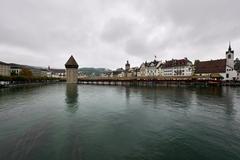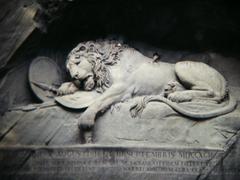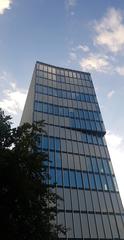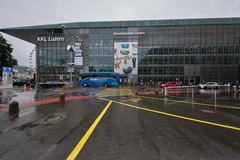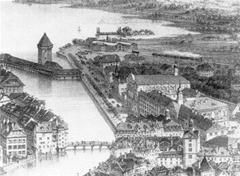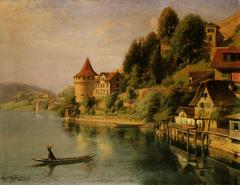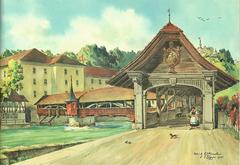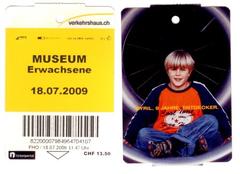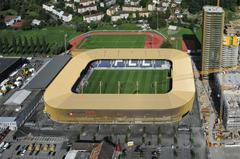Auguste Piccard Lucerne Visiting Hours, Tickets, and Historical Sites Guide
Date: 04/07/2025
Explore the legacy of Auguste Piccard—pioneering physicist, inventor, and explorer—at the Swiss Museum of Transport in Lucerne. This guide provides comprehensive information on the Auguste Piccard exhibition, including visiting hours, ticket options, accessibility, nearby Lucerne historical sites, and practical visitor tips, ensuring a memorable and enriching experience.
Table of Contents
- Introduction to the Auguste Piccard Exhibit
- Auguste Piccard: Legacy and Historical Significance
- The Mésoscaphe Auguste Piccard: Origins and Innovations
- Operational History and Restoration
- Visiting Information
- Exhibit Highlights
- Lucerne Historical Sites & Nearby Attractions
- Visitor Facilities and Accessibility
- Special Events, Guided Tours, and Photography
- Seasonal and Practical Tips
- Sustainability and Environmental Awareness
- Frequently Asked Questions (FAQ)
- Conclusion and Visitor Summary
- References
Introduction to the Auguste Piccard Exhibit
Located in the scenic city of Lucerne, Switzerland, the Swiss Museum of Transport houses a dedicated exhibit celebrating the pioneering achievements of Auguste Piccard and his family. The exhibit immerses visitors in the story of Swiss innovation, featuring original artifacts such as the iconic stratospheric balloon gondola, the bathyscaphe Trieste, and the Mésoscaphe Auguste Piccard—the world’s first tourist submarine. Interactive displays and multimedia presentations make the exhibit accessible and engaging for all ages, and its proximity to Lucerne’s old town and lakeside attractions ensures a rich cultural experience (Swiss Museum of Transport, Swissinfo).
Auguste Piccard: Legacy and Historical Significance
Auguste Piccard (1884–1962) is renowned for his dual achievements in high-altitude ballooning and deep-sea exploration. He was the first human to ascend into the stratosphere in a pressurized gondola and, later, alongside his son Jacques, developed the bathyscaphe Trieste, which reached the deepest known point in the Earth’s oceans. Piccard’s work expanded the frontiers of science and inspired generations of explorers. The Lucerne exhibit situates his achievements within a broader narrative of Swiss innovation and global scientific advancement (holidaystoswitzerland.com).
The Mésoscaphe Auguste Piccard: Origins and Innovations
Designed by Jacques Piccard and launched for the 1964 Swiss National Exhibition (Expo 64), the Mésoscaphe Auguste Piccard was the world’s first and largest submarine built for tourism. Constructed at the Giovanola factory in Monthey, it could carry up to 40 passengers and dive to depths of 150 meters. Key features included:
- Robust Pressure Hull: Ensured safe descents for non-scientific passengers.
- Large Observation Windows: Provided panoramic underwater views.
- Advanced Life Support: Maintained comfort and safety during multi-hour dives.
- Electric Propulsion: Enabled quiet, emission-free operation.
These innovations reflected the Piccard family’s expertise in deep-sea engineering and commitment to public engagement with science (RTS, renaudbaur.com).
Operational History and Restoration
During Expo 64, the Mésoscaphe completed over 1,100 dives in Lake Geneva, carrying approximately 33,000 passengers. Afterward, it participated in international research missions before being retired. In the early 2000s, the submarine underwent extensive restoration and was installed as a permanent exhibit at the Swiss Museum of Transport. Visitors today can explore the vessel’s interior and learn about its construction, operation, and impact on underwater tourism (RTS, blog.nationalmuseum.ch).
Visiting Information
Opening Hours
- Summer (April–October): 10:00 AM – 6:00 PM
- Winter (November–March): 10:00 AM – 5:00 PM
- Closed: December 24th and 25th
Ticket Prices
- Adults: CHF 32
- Seniors (65+), Students: CHF 28
- Children (6–16 years): CHF 14–16
- Children under 6: Free
- Family Ticket (2 adults + up to 3 children): CHF 75
Tickets can be purchased online or at the museum entrance. Advance booking is recommended during peak seasons (Swiss Museum of Transport, Swissinfo).
Location and Accessibility
- Address: Haldenstrasse 44, 6006 Lucerne
- Transport: 10-minute bus ride from Lucerne’s main train station (bus lines 6, 8, or 24), or a scenic 30-minute walk along the lake.
- Parking: On-site parking available.
- Accessibility: Fully wheelchair accessible, with multilingual signage and guided tours available upon request.
Travel Tips
- Arrive early, especially on weekends or holidays, to avoid crowds.
- Allocate at least 2–3 hours for the exhibit and other museum highlights.
- Check the museum website for special events, guided tours, and temporary exhibitions.
Exhibit Highlights
Bathyscaphe Trieste and Stratospheric Gondola
- Bathyscaphe Trieste: Highlights the historic 1960 descent to the Mariana Trench, with original components and detailed models.
- Stratospheric Balloon Gondola: Showcases the vessel that carried Piccard to the stratosphere in 1931, featuring interactive diagrams and scientific panels (Collection Online).
Interactive Experiences
- Virtual Reality: Simulate Piccard’s ascents and descents.
- Hands-On Engineering: Interactive stations for all ages to explore buoyancy, pressure, and atmospheric science.
- Archival Media: Rare footage, logbooks, and personal artifacts.
Lucerne Historical Sites & Nearby Attractions
Combine your museum visit with Lucerne’s top historical sites:
- Chapel Bridge (Kapellbrücke): Europe’s oldest covered wooden bridge.
- Water Tower (Wasserturm): Medieval city landmark.
- Musegg Wall: Historic city wall with accessible towers.
- Lion Monument (Löwendenkmal): Iconic sculpture commemorating Swiss Guards.
- Lake Lucerne Cruises: Scenic boat rides with panoramic alpine views.
All sites are within walking distance or a short transit ride from the museum (Miss Tourist).
Visitor Facilities and Accessibility
- Dining: On-site cafés and restaurants cater to diverse tastes.
- Family-Friendly: Interactive exhibits and kid-friendly activities throughout the museum.
- Visitor Cards: The Lucerne Visitor Card (often provided by hotels) offers free public transport and discounts on attractions (Luzern.com).
Special Events, Guided Tours, and Photography
- Guided Tours: Available in multiple languages, focusing on the Auguste Piccard exhibit. Book in advance for tailored experiences.
- Events: Check the museum’s calendar for workshops, lectures, and family days.
- Photography: Permitted throughout the exhibit (no flash or tripods). Top spots include the submarine interior and panoramic windows.
Seasonal and Practical Tips
- Spring/Autumn: Mild weather and fewer crowds—ideal for sightseeing.
- Summer: Peak season; book tickets and accommodations early.
- Winter: Enjoy festive events and combine your visit with skiing or Christmas markets.
- Weather: Lucerne’s climate can change rapidly; bring layers and plan both indoor and outdoor activities (Destination Abroad).
Sustainability and Environmental Awareness
Lucerne prioritizes eco-friendly transportation and responsible tourism. The Swiss Museum of Transport integrates environmental education and sustainability, echoing the Piccards’ legacy of environmental stewardship (Tales from the Balcony).
Frequently Asked Questions (FAQ)
What are the Auguste Piccard exhibit visiting hours?
Daily from 10:00 AM to 5:00 PM (winter) or 6:00 PM (summer).
Where can I buy tickets?
Purchase online via the museum’s official website or at the entrance.
Is the museum accessible for visitors with disabilities?
Yes, it is fully accessible, with guided tours and multilingual signage.
Are guided tours available specifically for the Auguste Piccard exhibit?
Yes, tours are available and can be booked in advance.
Is the exhibit family-friendly?
Absolutely. Interactive displays and child-friendly activities abound.
Conclusion and Visitor Summary
The Auguste Piccard exhibit at the Swiss Museum of Transport in Lucerne offers a unique journey into the history of scientific exploration, engineering innovation, and Swiss cultural heritage. With engaging displays, accessible facilities, and proximity to Lucerne’s most iconic sites, the museum provides an enriching experience for visitors of all ages and interests.
To make the most of your visit:
- Check opening hours and book tickets in advance.
- Explore Lucerne’s historical sites and natural beauty.
- Download the Audiala app for audio tours and up-to-date information.
- Follow the museum on social media for event updates and tips.
Embrace the spirit of discovery and let the legacy of Auguste Piccard inspire your Lucerne adventure (Swiss Museum of Transport, Swissinfo).
References and Further Reading
- Swiss Museum of Transport
- RTS
- Holidaystoswitzerland.com Swiss Museum of Transport Visitor Guide
- Swissinfo: Historic Piccard Submarine Restored
- Miss Tourist: Things to Do in Lucerne
- Tales from the Balcony: The Birth of Submarine Tourism
- Destination Abroad: Is Lucerne Worth Visiting?
- Luzern.com Events Calendar
- Renaud Baur Photography – Mésoscaphe
- Ex-expo.ch – The Mésoscaphe
- Blog National Museum Switzerland – The Submarine Mésoscaphe Auguste Piccard
- Go Travel Daily – Top Attractions & Activities Lucerne 2025
- MySwissAlps – Museum of Transport
- Collection Online – Swiss Museum of Transport
